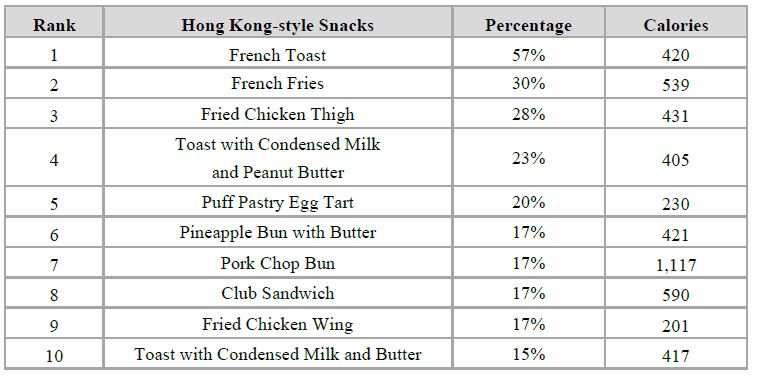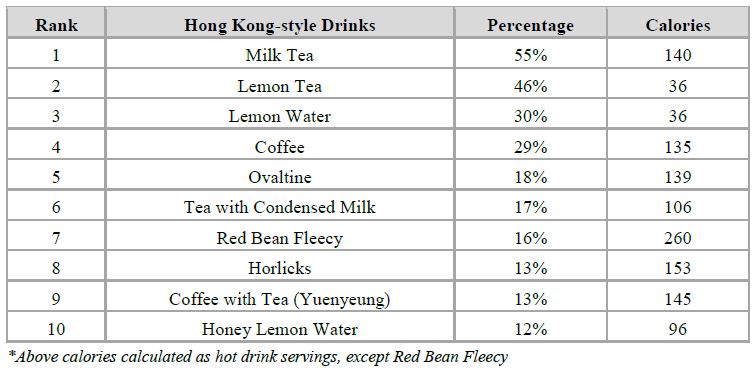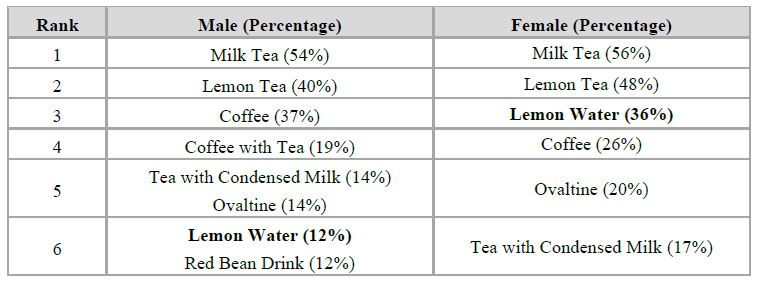healthyD Unveils Survey Results of “Most Favourable Hong Kong Drink and Snack”

healthyD unveils survey results of
“Most Favourable Hong Kong Drink and Snack”
- Nearly 90% of respondents visit cha chaan teng on alternate day
Hong Kong-style milk tea & French toast rank top favourites - Annual consumption of 320 million French toast servings
Can surround the Earth’s circumference - Nearly 80% of respondents loyal to cha chaan teng amid calories concerns
[Hong Kong – 16th July 2019] A hands-down dining favourite among Hongkongers, cha chaan teng is more than a Hong Kong’s food icon, but also an ingredient of the city’s local culinary culture. Convenient and fast serving, cha chaan teng has since been part of Hong Kong’s daily diet. healthyD, a health media platform of ESDlife, initiated an online “Most Favourable Hong Kong Drink and Snack” survey from April to July 2019 to better understand the impression, habits, favourite cha chaan teng drinks and snacks, and overall awareness of healthy diet among Hongkongers. A total of 1,233 completed online questionnaires were received.
Hong Kong diners visit cha chaan teng on alternate days and loyalty grows by age. Respondents aged 50 and above paid over 200 visits a year.
The survey revealed that 88% of respondents were regular cha chaan teng or bing sutt diners with a weekly average of 3.6 visits, or equivalent to visit on alternate days. Findings suggested that loyalty to cha chaan teng or bing sutt grew by age. In terms of cha chaan teng dining frequency, respondents aged 50 and above reached a staggering weekly average of 4.1 visits or over 200 visits per year. In comparison, respondents aged under 30 are only less avid to dining at cha chaan teng with a weekly average of 3.2 visits or 166 visits per year. (See Appendix – Figure 1) Among the main reasons for dining at cha chaan teng are “convenience” (68%), “wide variety of dishes” (41%), “affordable price” (40%), “fast serving” (36%) and “deliciousness” (36%). Some respondents purposefully visited cha chaan teng for “tasting designated food and drink designated drinks” (32%).
Loyal cha chaan teng diners in each of four daily meals. Young respondents favours cha chaan teng afternoon tea.
When asked about what time they usually visited cha chaan teng or bing sutt, Hongkongers are generally open to dining at cha chaan teng for any meal of the day. Among all, respondents mostly went to cha chaan teng for “breakfast” (57%), followed by “lunch” (56%) and “afternoon tea” (47%). In terms of age group, respondents aged under 30 usually most visited cha chaan teng during afternoon for afternoon tea (56%); cha chaan teng is a regular working day or hangout lunch option for respondents aged between 30 and 39 (60%); cha chaan teng breakfast is a preferred option by respondents aged between 40 and 49 (61%), and those aged 50 and above (64%), respectively. Data above are valid proofs of loyal cha chaan teng diners for three main meals and afternoon tea. (See Appendix – Figure 2)
Hongkonger’s annual consumption of 320 million French toast servings can surround the Earth’s circumference.
Without surprise, the top 3 popular cha chaan teng snacks are fried dishes aka evil foods, namely French toast (57%), French fries (30%) and fried chicken thigh (28%). (See Appendix – Figure 3) Take the French toast as an example: Respondents had an average 1.1 servings per week; with an adult population (aged 20 and over) of 6.29 million[1], Hongkongers are estimated to consume over 320 million French toast servings per year[2], sufficient enough to surround the Earth’s circumference[3]. Commenting on the highly popular French toast, Cynthia Wong, Senior Nutritionist of NutraCare Consultancy underlined an afternoon tea combo of a French toast (420 calories) and a glass of Red Bean Fleecy (260 calories) accounts for an intake of 680 calories; for a women weighed at 55kg and running at the speed of 7km/hour, it takes 1 hour and 46 minutes to fully consume the calorie intake. She also suggested healthier afternoon tea combo such as a toast with jam (184 calories) and a glass of iced lemon tea with 1 tablespoon of syrup added separately (20 cal.) rather than choosing high fat, high sugar delicacies like French toast and Red Bean Fleecy.
Respondents have true love on Hong Kong-style milk tea averaging over 2 cups per week.
Hong Kong-style milk tea is a must-have in cha chaan teng. It is also the top drink choice of over 55% of respondents, averaging 2.1 cups per week. Other drink preferences are lemon tea (46%) on an average of 1.5 cups per week; lemon water (30%) on an average of 1 cup per week; and coffee (29%) on an average of 1.7 cups per week. (See Appendix – Figure 4) The survey also revealed the difference of drink preference between male and female respondents. In addition to Hong Kong-style milk tea and lemon tea, more female respondents (36%) choose lemon water as immediate alternative than male respondents (12%), an indication of female leaning to heathier drink choice than male. (See Appendix – Figure 5) Although there were respondents ordering drink in “less sweet” (50%), Wong reiterated that “less sweet” did not effectively translate into low calorie intake; in the case of a cup of hot Hong Kong-style milk tea (140 calories), it only trims 32 calories when served without sugar; having a cup of regular Hong Kong-style milk tea daily will translate into a weekly weight gain of nearly 2 lbs. To taste Hong Kong-style milk tea healthily in a daily basis, Wong recommends to order a cup without sugar and less milk at cha chaan teng, or to prepare a cup by yourself at home with low-fat milk or skimmed milk rather than evaporated milk to reduce fat and calorie intake.
80% of respondents loyal to cha chaan teng amid health concerns. Nutritionist advises more exercise to burn calories
The survey also found out a dilemma: When 83% of respondents thought food and drink served at cha chaan teng were “very unhealthy” or “not so healthy”, 61% stated that they had no intention to go less to cha chaan teng due to health concern (See Appendix – Figure 6); among the 79% of respondents who remain loyal, they were “unlikely” (60%) or “definitely unable” to stop dining at cha chaan teng. (See Appendix – Figure 7) In fact, food offerings at cha chaan teng are mostly high-fat, high-calorie and high-salt. For eating healthily at cha chaan teng, Wong recommended dishes with lower calories, such as beef macaroni in fresh tomato soup or vermicelli soup with shredded pork and preserved potherb mustard for breakfast; rice soup or lean barbecue pork for lunch; toast with jam for afternoon tea; and pork with creamed corn or tomato and beef rice for dinner. Besides, it is essential to have 30 minutes of moderate-intensity cardio exercise every day to enhance cardiovascular performance, burn calories and to keep body weight stable.
[1] Population by Age Group and Sex, Mid-2018, Statistics from Census and Demographic Statistics Branch, The Census and Statistics Department.
[2] Calculation: 57.2 servings (average annual French toast consumption per respondent) x 6.29 million (Hong Kong adult population) x 88% (proportion of regular cha chaan teng or bing sutt diners)
[3] Calculation: 12 cm (French toast’s length or width) x Earth’s circumference
Appendix
Figure 2: What Time Hongkongers Usually Visit Cha Chaan Teng (By Age Groups)

Figure 2: What Time Hongkongers Usually Visit Cha Chaan Teng (By Age Groups)

Figure 3: Top 10 Hong Kong-style Snacks

Figure 4: Top 10 Hong Kong-style Drinks

Figure 5: Difference of Drink Preference Between Male and Female Respondents

Figure 6: Intension to Go Less to Cha Chaan Teng Due to Health Concern

Figure 7: Are Hongkongers Able to Give Up Cha Chaan Teng in the Future






– End –
About ESDlife
ESDlife, a joint venture of CK Hutchison Holdings Limited and Hewlett-Packard HKSAR established in 2000, builds digital engagement through a collective of trusted and award-winning services. It offers online lifestyle media platform including wedding, family and health; e-commerce and digital solutions that helps brands achieve their goals. Through these, ESDlife aims to help people live more rewarding, fulfilled lives. For more information, please visit: www.ESDlife.com.
嘉賓出席「港人衛生意識及皮膚健康調查」結果發布會-1-149x108.jpg)

